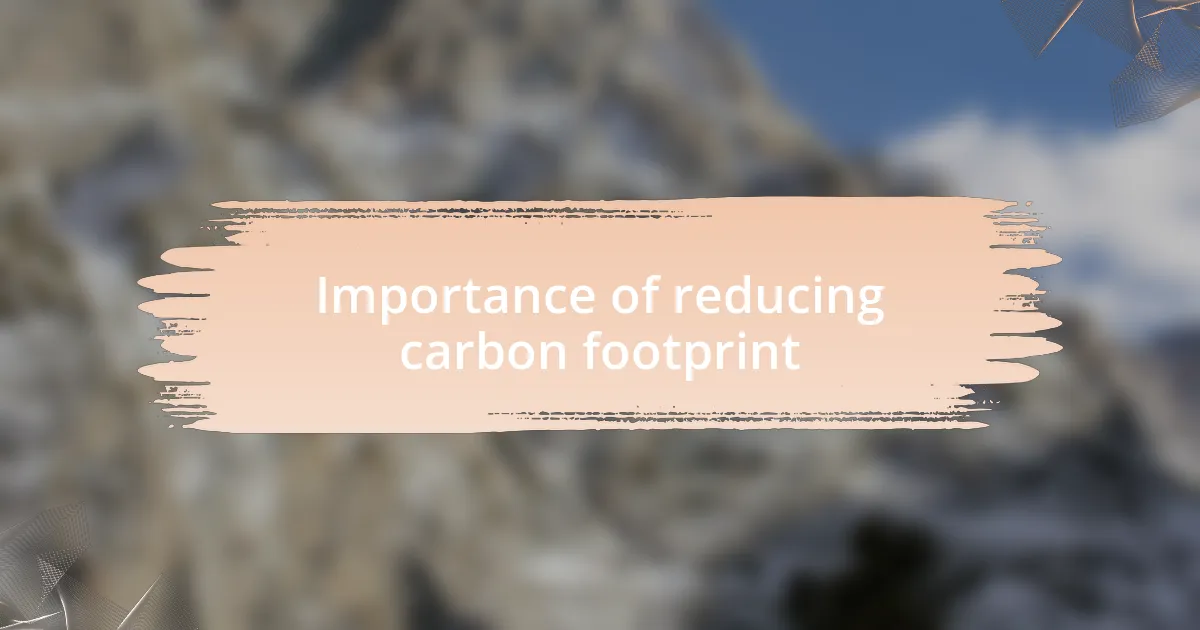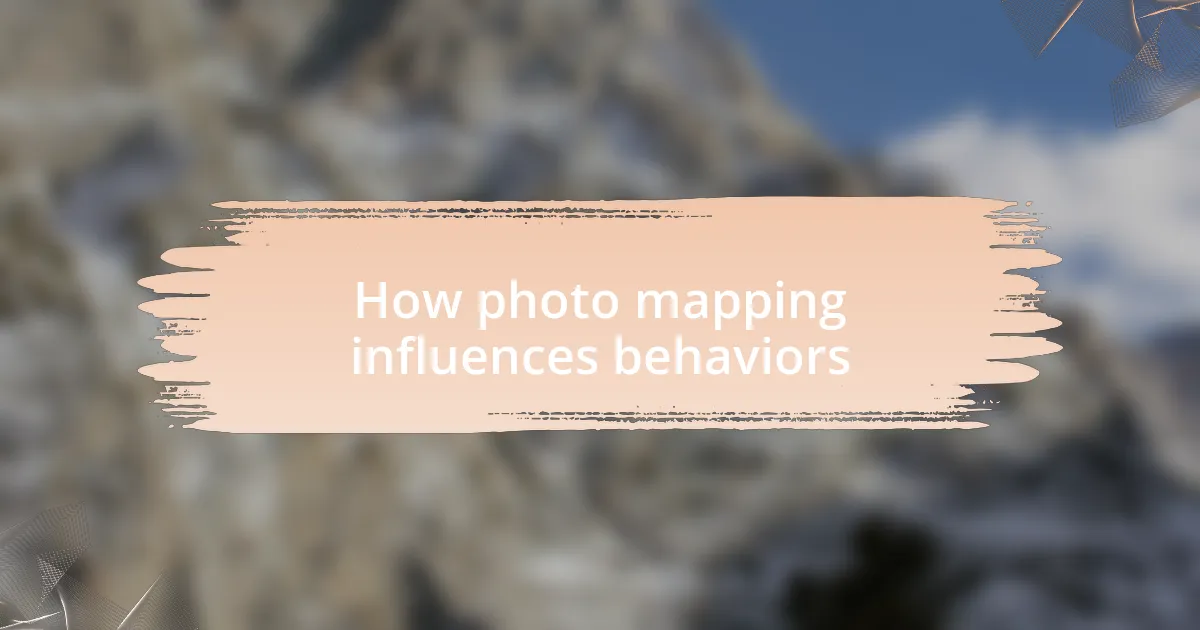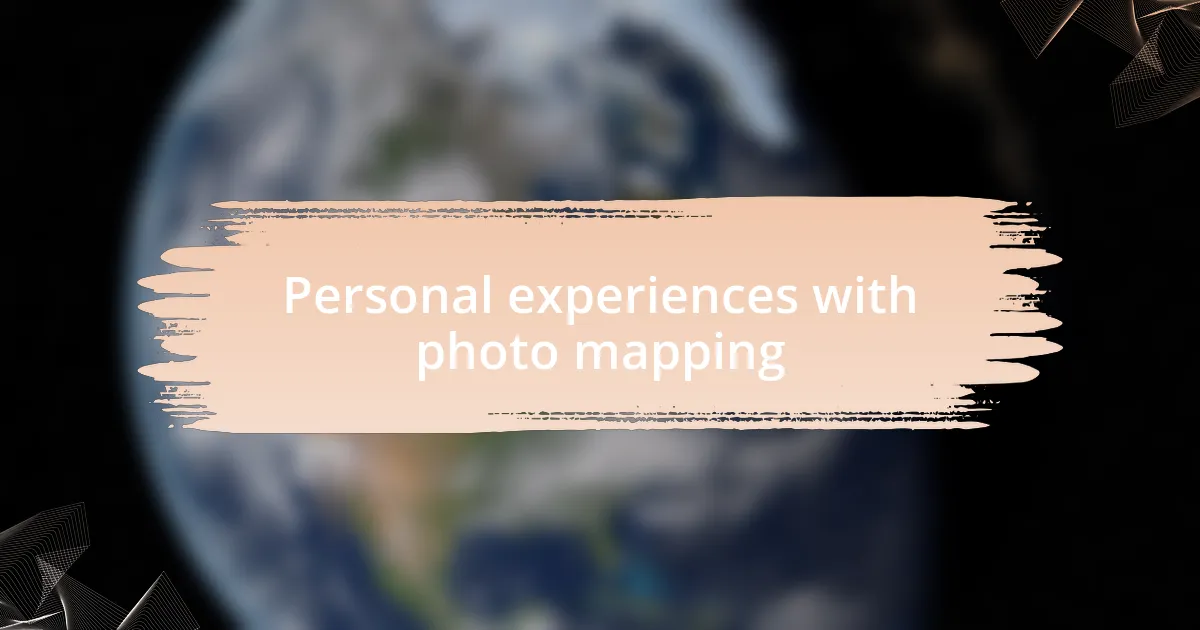Key takeaways:
- Understanding and reducing carbon footprint is vital for sustainability and impacts future generations.
- Small personal actions, such as using reusable products or biking, can lead to significant environmental benefits and improved well-being.
- Instagram photo mapping enhances engagement with surroundings and promotes awareness of environmental issues through visual storytelling.
- Sharing personal experiences can mobilize communities and deepen connections to nature, encouraging collective responsibility for preservation.

Understanding carbon footprint
Understanding carbon footprint is crucial in our journey towards sustainability. It essentially measures the total greenhouse gas emissions, particularly carbon dioxide, that result from our daily activities. Have you ever paused to consider how your morning coffee or that frequent drive contributes to this footprint?
In my own experience, I realized the impact of small choices when I swapped my daily takeaway coffee for a reusable cup. While I initially thought it wouldn’t make much difference, it’s fascinating to see how those little actions accumulate over time. It left me wondering, if we all made conscious decisions, how much could we collectively reduce our carbon emissions?
It’s also important to remember that our carbon footprint isn’t just about direct actions; it encompasses the often-overlooked elements, like the energy used to produce our food and goods. Can you imagine how much energy goes into that new gadget you just bought? By exploring this, I became more mindful about my consumption habits, striving to choose products with a lower environmental impact.

Importance of reducing carbon footprint
Reducing our carbon footprint is essential for safeguarding the planet. Every small effort we make contributes to the bigger picture, pushing us closer to combating climate change. I remember when I first calculated my carbon footprint; the number overwhelmed me. It brought a sense of urgency and responsibility — I realized I wasn’t just impacting my environment, but that my choices affected future generations.
There’s something profoundly impactful about making eco-friendly choices. For me, it was when I started biking instead of driving short distances. At first, it felt like a chore, but soon I found joy in the fresh air and the physical activity. Not only did I cut down on emissions, but I also improved my health and mental well-being. Isn’t it interesting how one change can bring multiple benefits?
Ultimately, reducing our carbon footprint fosters a deeper connection with our environment and community. When I participated in a local clean-up drive, I felt a sense of camaraderie with others who shared the same passion for sustainability. That experience opened my eyes: taking action goes beyond personal choices; it cultivates a collective movement towards a healthier planet. What steps can we take together to amplify this change?

Basics of Instagram photo mapping
Instagram photo mapping is a fascinating tool that allows users to visually tell a story through the places they visit and capture in photos. Each image can be tagged with location data, providing context and depth to the content. When I started using this feature, I found it transformed not just how I shared experiences, but also how I connected with my surroundings.
As I explored different neighborhoods, I began to notice nuances I had previously overlooked. One day, while capturing photos of a local park, I realized each post I shared contributed not just to my personal brand, but also to a bigger narrative about that community. It made me wonder—how could each of us inspire others to appreciate the hidden gems in our own backyards through thoughtful photo mapping?
The beauty of Instagram photo mapping lies in its potential to foster awareness and engagement. While pursuing my photography hobby, I often included captions about the environmental significance of each location. When people commented and engaged with my posts, I felt a sense of shared responsibility. It made me think: what if we all used our platforms to highlight not just beautiful spots, but also the importance of preserving them?

How photo mapping influences behaviors
Photo mapping has a unique way of shifting our perspectives. I recall a time when I posted a picture of a local beach littered with plastic. The comments flowed in, and it sparked a conversation about pollution and environmental responsibility. I realized how a simple photo could mobilize others to take action—each click shared a bit of the ocean’s story, urging us all to consider how our behaviors contribute to the greater ecological narrative.
When I map my photos, I engage in reflective thinking about the places I visit. I’ve found that capturing a moment in a community garden not only showcased its beauty but also the importance of urban green spaces. By sharing these images, I hope to inspire others to explore similar initiatives in their neighborhoods. It’s fascinating how visual storytelling can deepen our understanding of local ecosystems and motivate us to protect them.
In sharing my journey through Instagram, I often ponder—how can we cultivate a mindful relationship with our environment through photo mapping? Each image becomes a dialogue between my experiences and the viewer’s perceptions. By emphasizing a narrative that includes both beauty and environmental challenges, I aim to ignite curiosity and responsibility. The transformation lies not just in sharing photos, but in the ripple effects those images create in our consciousness.

Personal experiences with photo mapping
As I began photo mapping my hiking adventures, I noticed a shift in how I interacted with nature. One particularly memorable hike involved capturing images of a serene lake surrounded by towering trees. By sharing those moments, I found myself feeling both grateful and protective of these natural wonders, prompting me to research and voice concerns about local conservation efforts. Have you ever considered how a simple photo could influence your commitment to preserving the environment?
On one occasion, I documented a volunteer day where I helped clean up a riverbank. The photos I posted not only highlighted the joy of community collaboration but also brought attention to the stark contrast of our environment’s state. Seeing people resonate with my experience encouraged me to keep advocating for such initiatives. It makes me wonder: don’t we all have a role to play in shaping the narrative of our shared spaces?
Through my photo mapping journey, I’ve also discovered that each snapshot stirs my emotions in ways I hadn’t anticipated. Capturing the vibrant colors of a blooming flower in a local park reminded me of the resilience of nature, creating a personal connection that sparked a desire to learn more about local flora and fauna. Isn’t it intriguing how an image can serve as a catalyst for deeper engagement with our surroundings?